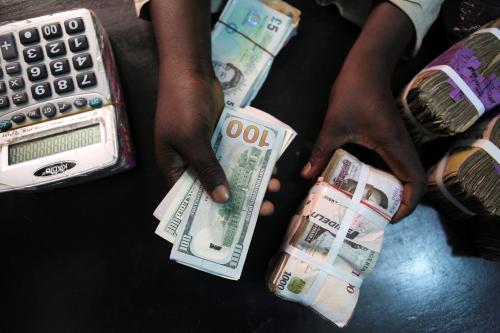Since 2013, debt in Africa has risen rapidly, with the median debt-to-GDP ratio as percent of GDP increasing to 53 percent in 2017. As a result, about one-third of the countries in sub-Saharan Africa are classified as being either in or at high risk of debt distress, including the majority of countries that benefited from debt relief in the 1990s from the International Monetary Fund and World Bank. These observations are fueling concerns that the region is facing another systemic debt crisis.
Our analysis suggests that while another systemic sovereign debt crisis is not imminent, the rapid pace of the debt increase in recent years, as well as debt servicing costs and important changes in the structure of the region’s debt buildup, compared with that of the Heavily Indebted Poor Countries (HIPC) and Multilateral Debt Relief Initiative (MDRI) era, are unsettling.
Despite the rapid increase in debt, the median debt-to-GDP ratio for African countries remains relatively low (53 percent) compared with 90 percent during the HIPC/MDRI period. Moreover, although the increase in debt has been very rapid in recent years, the pace of accumulation has slowed considerably. Between 2013 and 2016, the median debt-to-GDP ratio rose from 33 percent to 52 percent in 2016. That is roughly 5 percentage points of GDP per year.
Why has debt increased?
We point to some key factors. First, the global financial crisis and the 2014 terms-of-trade shock hit economies around the world hard. Sub-Saharan African countries were not spared. Part of the African debt increase reflected these adverse shocks and, in some cases, policy responses to cushion them. The increase in debt was particularly rapid for the region’s oil exporters.
Second, in the face of low domestic saving rates, growing financing needs, particularly for infrastructure, led governments to contract debt from a variety of sources: international debt markets, domestic markets, multilateral institutions, members of the major creditor country group called the Paris Club, and non-Paris Club countries, most notably China.
Third, the ensuing ultra-low interest rates prevailing in the U.S. and other advanced economies’ markets led private market lenders to step up lending to frontier markets, including to several African countries, in a search for higher yielding assets. For their part, several African countries began in 2006 to access international capital markets, with the pace of issuance and number of countries entering the markets ramping up after 2012. Additional contributing factors include exchange rate depreciations, which raise the domestic currency value of unhedged foreign currency debt, and, in some cases, poor governance.
Looking ahead, most of the drivers of the increases in debt appear to be dissipating. Commodity prices have retracted their declines, economic growth is firming up, exchange rates have strengthened, and, in many cases, fiscal consolidation is under way. Accordingly, the debt ratio plateaued in 2017 and, barring unexpected shocks or fiscal slippages, it is projected to decline to 47 percent by 2023. However, debt levels are only an incomplete picture of potential debt crisis. The other debt servicing cost dimension, as well as the design features of debt contracting and the creditor structure, matter to a country’s ability to achieve debt sustainability and hence avert potential crisis. On that score, there is a major difference between the HIPC/MDRI era and the current period.
Why is the current debt so worrisome?
The current debt buildup is characterized by increases in both domestic and external debt, but external debt still predominates, with a share of 60 percent. While the previous external debt buildup was due to an increase in lending by multilateral institutions, the current one is due to a significant increase in private borrowing. Moreover, a higher share of the region’s borrowing is on non-concessional terms, while the share of multilateral and bilateral debt declined.
Indeed, since 2006, 15 sub-Saharan African countries have regularly issued foreign currency bonds in international debt markets. In particular, there has been a prevalence of Eurobond issuance. The maturities of the bonds issued have generally ranged between 5 to 10 years. This relatively short maturity structure does not match the life of infrastructure projects with much longer time return profiles. In this regard, the recent push by countries to issue 30-year bonds is a step in the right direction.
Another noteworthy change in the region’s debt landscape is the more diffuse creditor base. The shift from commercial rather than concessional loans has contributed to a diffusion of the credit base. Moreover, there has been a significant shift in bilateral partners. Notably, the region’s bilateral debt has increasingly moved away from the Paris Club member countries toward non-traditional lenders, such as China. In 2017, the Paris Club countries owned less than 7 percent of Africa’s outstanding external debt, down from 15 percent in 2008.
The higher share of debt contracted on commercial terms has caused debt servicing costs to increase rapidly. Interest cost as a share of government revenues doubled from 5 percent in 2012 to 10 percent in 2017, its highest level since the early 2000s. The increase has been particularly large in Angola, Nigeria, Ghana, and Burundi, rising by almost 20 percentage points. As a result, interest costs now account for 10 percent of government revenues in 17 countries, compared with six countries in 2012. In one-third of African countries, the interest cost has now reached or exceeded its HIPC/MDRI level. This significant deterioration in interest rate cost despite relatively low debt levels, points to a possible deterioration in the quality of debt during the current period of debt accumulation compared with the HIPC/MDRI era.
To be sure, there are significant positives to the changes in the structure of the current debt buildup. Access to international financial markets is an inevitable and welcome part of economic development. This access allows for a diversification of funding sources and subjects the economies to the discipline of financial markets, and increased attention to domestic economic developments and policies.
However, the access to market-based financing also carries some risks, including exposure to global market volatility and other developments outside the control of local policymakers. In particular, such swings in the global financial markets are potentially around interest rates, exchange rates, and debt rollover risks. Moreover, the region’s increasingly diffuse creditor base reflects more diversified funding partners and likely attests to greater confidence in the region’s economic prospects. However, the plurality of creditors can make coordination in the event of debt resolution more complex and protracted.
Finally, commodity-backed loans could allow African countries to access more financing at a lower cost if the terms are well structured and transparent. In sum, the challenge for policymakers is to take advantage of the new financing opportunities while ensuring that the debt management frameworks and approaches are robust to manage the new risks they bring. Even though an African sovereign debt crisis is not imminent, there should be proactive measures in place to improve preparedness and bolster the capacity for crisis resolution if it ever occurs.
What’s next for policymakers?
The debate around another debt crisis less than two decades after the MDRI/HIPC debt relief serves as reminder that progress to address the structural issues that constrain sustainable development financing has not been sufficient. Importantly, there should be concerted efforts to boost domestic resource mobilization, particularly efficiency in tax revenue collection, combating illicit capital flows, strengthening governance around natural resources, and accelerating the development of domestic financial markets. These are areas international partners can support, including helping build capacity for domestic resource mobilization, debt management, financial infrastructure, and strengthening capacity of development banks to play a larger role in the region’s infrastructure financing. As long as large funding gaps persist in infrastructure, these banks will continue to put pressures on government finances and debt.
The Brookings Institution is committed to quality, independence, and impact.
We are supported by a diverse array of funders. In line with our values and policies, each Brookings publication represents the sole views of its author(s).








Commentary
Looming debt crisis in Africa: Myth or reality?
April 5, 2019